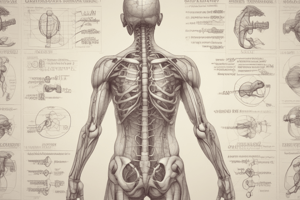Podcast
Questions and Answers
The heart is ______ to the liver.
The heart is ______ to the liver.
superior
The stomach is ______ to the lungs.
The stomach is ______ to the lungs.
inferior
Sternum is ______ to the heart.
Sternum is ______ to the heart.
anterior
Ulna is ______ to radius.
Ulna is ______ to radius.
Lungs are ______ to the heart.
Lungs are ______ to the heart.
Eyes are ______ to the nose.
Eyes are ______ to the nose.
The lung is ______ to the stomach.
The lung is ______ to the stomach.
The stomach is ______ to the lung.
The stomach is ______ to the lung.
Medical term for body position lying on their tummy.
Medical term for body position lying on their tummy.
Medical term for body position lying face up/lying on your back.
Medical term for body position lying face up/lying on your back.
It is a medical position involves lying on the right side.
It is a medical position involves lying on the right side.
It is a medical position involves lying on the left side.
It is a medical position involves lying on the left side.
In a ______ position, a person is sitting straight up or leaning slightly back.
In a ______ position, a person is sitting straight up or leaning slightly back.
Flashcards are hidden until you start studying
Study Notes
Anatomical Relationships
- The heart is located above (superior) the liver, indicating its position in the upper part of the abdominal cavity.
- The stomach is found below (inferior) the lungs, positioning it within the abdominal cavity beneath the thoracic cavity.
- The sternum, situated in front (anterior) of the heart, protects vital thoracic organs and provides structural support.
- The esophagus is located behind (posterior) the trachea, making it part of the digestive system adjacent to the respiratory system.
- The ulna is positioned closer to the midline (medial) of the body compared to the radius, which is notable in the structure of the forearm.
- The nose is placed closer to the midline (medial) than the eyes, establishing facial symmetry and alignment.
- The torso is found closer to the midline (medial) than the arms, indicating its central role in the body’s structure.
- The lungs are situated to the sides (lateral) of the heart, emphasizing their role in respiration away from the central circulatory system.
- The eyes are located to the sides (lateral) of the nose, a characteristic feature of human facial anatomy.
- The arms are positioned to the sides (lateral) of the torso, illustrating their function as appendages extending from the central body.
- The transverse colon is found between (intermediate to) the ascending and descending colon, indicating its central role in the large intestine.
Anatomical Positions
- The heart is located above the liver, indicating a superior anatomical relationship.
- The stomach is positioned below the lungs, demonstrating an inferior anatomical orientation.
- The sternum, or breastbone, is situated in front of the heart, marking an anterior position.
- The esophagus is positioned behind the trachea, reflecting a posterior anatomical location.
- The ulna, a forearm bone, is closer to the midline of the body than the radius, showing a medial relationship.
- The nose is centrally located between the eyes, emphasizing its medial position.
- The torso is positioned towards the center of the body, illustrating its medial aspect relative to the arms.
- The lungs are found on each side of the heart, demonstrating a lateral position.
- The eyes are situated on either side of the nose, reinforcing their lateral orientation.
- The arms are positioned further away from the torso, indicating a lateral relationship.
- The transverse colon lies between the ascending and descending colon, representing an intermediate position.
Anatomical Positions
- The lung is positioned above (superior) the stomach.
- The heart is also located above (superior) the liver in the body.
- The stomach is positioned below (inferior) the lungs.
- The sternum is located in front of (anterior) the heart.
- The esophagus is located behind (posterior) the trachea.
- The ulna is situated towards the body's midline (medial) compared to the radius.
- The nose is found at the midline (medial) relative to the eyes.
- The torso is located at the midline (medial) compared to the arms.
- Lungs are located to the sides (lateral) of the heart.
- The eyes are positioned to the sides (lateral) of the nose.
- The arms are located to the sides (lateral) of the torso.
- The transverse colon is situated between (intermediate) the ascending and descending colons.
Body Positions in Anatomy
- Prone Position: Body lies facing down, commonly used for surgeries or certain medical examinations.
- Supine Position: Body lies facing up, often used for resting or during medical assessments such as heart or lung examinations.
- Right Lateral Recumbent: Body lies on the right side, helpful for specific medical procedures and assessments of organs like the liver and gallbladder.
- Left Lateral Recumbent: Body lies on the left side, frequently used in obstetrics to improve blood flow to the fetus and to monitor heart activity.
- Fowler’s Position: Sitting straight up or at a slight angle, beneficial for patients with respiratory issues or for ease of comfort during meals.
Studying That Suits You
Use AI to generate personalized quizzes and flashcards to suit your learning preferences.




